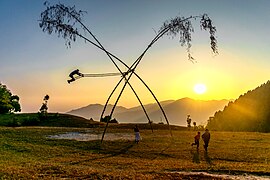Linge Ping

Linge Ping (Nepali: लिङ्गे पिङ) is a traditional swing constructed during the festival of Dashain mainly in Nepal. The shape of the swing is in the shape of Shiva Linga, hence the name. It is believed that one must leave the ground once a year by riding the swing in the Dashain festival.[1][2] During Dashain, multiple fairs are held and Linge Ping and wooden Ferris wheels are constructed.[3]
Construction[edit]
The swing is built with four bamboos connected together at the top and jute rope is used to make the hanging portion of swing. It is ridden alone or by two persons in sitting or standing position. The momentum is gained initially by the external force but later the rider pushes themselves by changing their position to gain elevation.
The tradition of constructing the swing is reducing recently due to lack of interest in young generation[4] and lack of space in urban areas.[5][6]
Gallery[edit]
-
Children playing Linge Ping at Palpa, Nepal (2019)
-
A man swinging in the swing during Dashain festival
-
Children standing in a queue for the swing
-
A four-part swing
References[edit]
- ^ "Sajha.com - Traditional Nepali swing, kite flying on the verge of disappearance due to lack of space". Sajhasansar. Retrieved 2020-10-20.
- ^ "Why is Dashain a time of great rejoicing and festivity for Nepalis". Retrieved 2020-10-20.
- ^ "Once upon a time, Dashain was all about the swing". kathmandupost.com. Retrieved 2022-10-20.
- ^ HABIB, MOHAMMAD. "'Linge Ping' on the verge of extinction (with photos)". My Republica. Retrieved 2020-10-20.
- ^ Chitrakar, Rajjan Man (2015). "Transformation of public space in contemporary urban neighbourhoods of Kathmandu Valley, Nepal: An investigation of changing provision, use and meaning". Queensland University of Technology. Retrieved 2020-10-20.
- ^ "हराउँदै दशैंमा पिङ संस्कृति". Retrieved 2020-10-20.




